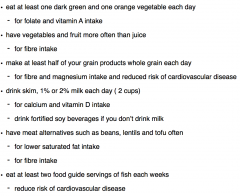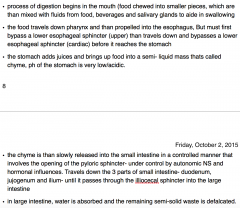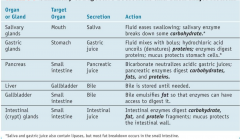![]()
![]()
![]()
Use LEFT and RIGHT arrow keys to navigate between flashcards;
Use UP and DOWN arrow keys to flip the card;
H to show hint;
A reads text to speech;
66 Cards in this Set
- Front
- Back
|
WHAT are the 6 classes of nutrients |
Minerals Water Vitamins Carbs Protein Fat |
|
|
what are the energy values for carbs, protein, fats and alcohol, (kcal/gram) |
carbs: 4 protein = 4 fats = 9 alcohol = 7 |
|
|
is alcohol considered a nutrient, why or why not? |
it is not a nutrient because it interferes with the body's growth, maintenance and repair |
|
|
what is EAR |
Estimated average requirement:the average daily amount of a nutrient that will maintain a specific biochemical or physiological function in half the healthy people of a given age and gender group
|
|
|
what is RDA |
recommended dietary allowances: the average daily amount of a nutrient considered adequate to meet the known nutrient needs of practically all healthy people; a goal for dietary intake *set well above EAR
|
|
|
what is AI |
adequate intakes: the average daily amount of a nutrient that appears sufficient to maintain a specified criterion; a value used as a guide for nutrient intake when an RDA cannot be determined
|
|
|
what is UL |
tolerable upper intake levels: individual tolerances for nutrients vary, and somewhere above the recommended intake is a point beyond which a nutrient is likely to become toxic ex: vitamin A
|
|
|
describe the nutrient assessment: individual level |
physical exam of the body
provides clues to nutritional status (diet record)lab tests -reveal values of certain nutrients in blood most useful in detecting early stages of deficiency |
|
|
what nutrients are organic |
carbs, fats, proteins, alcohol
|
|
|
what nutrients are inorganic |
vitamins, minerals, water
|
|
|
whats the difference between organic and inorganic? |
organic id energy yielding, inorganic is not |
|
|
what is satiety? |
feeling of fullness |
|
|
what influences our food choices? |
preferenceshabit availability traditionconnivencesocial interactionseconomybody weight/imagevaluespositive/negative associationshealth benefits
|
|
|
how does the body use energy yielding nutrients |
fuel:
-supports all body activities - storage for later useraw materials for building the body’s tissues and regulating activities (protein) |
|
|
describe vitamins |
essential, organic material 13 vitamins -water or fat soluble support the production of energy (B Vitamins) |
|
|
describe minerals |
inorganic
16 are essential indestructible do not yield energy (but are involved energy) |
|
|
what is the science of nutrition? |
“study of nutrients and other substances (antioxidants) in food and the body’s handling of them”
|
|
|
investigator and participant are blind
|
double blinding |
|
|
placebos
|
(greek = I will please) induced psychological response
|
|
|
what causes anemia? |
when hemoglobin contains too little iron |
|
|
acceptable macronutrients Distributions Ranges (AMDR)
|
- 45-65% k calories from carbohydrates
- 20-35% k calories from fat - 10-35% k calories from protein |
|
|
USING NUTRIENT RECOMMENDATIONS
|
Estimates apply to healthy people (adjustments maybe required)
recommendations are for the majority achieve goals via food estimates apply to average daily intakes each has a unique purpose |
|
|
what are the 3 groups of health claims |
disease risk reduction claims
function claims ( contains Vitamin a) general health claims |
|
|
what are the 4 food groups and what nutrients do they contribute? |
1. vegetables and fruit
- contribute carbs, fibre, folate, vitamin A, C, K, magnesium and potassium 2. Grain Products - contribute carbs, fibre, folate, thiamin, riboflavin, niacin, magnesium and iron 3. Milk and Alternatives - contribute protein, riboflavin, Vit. A, D,B12, calcium, magnesium, phosphorus, potassium and zinc 4. Meat and Alternatives - contribute protein, thiamin, niacin, vitamin B6, B12, E (etc) |
|
|
what are the six basic diet planning principles |

|
|
|
what are the challenges of digestion |
tasks of the mouth (crushing), diaphragm, steady movement, lubrication of food ,digestive enzyme functions, management of waste
|
|
|
what is the GI tract |
flexible, muscular tube that extends from the mouth through esophagus and stomach, intestines, rectum, anus
|
|
|
what is the inner space within the GI tract called |
lumen |
|
|
describe the process of digestion |

|
|
|
what are the 3 layers of the stomach? |
longitudinalcirculardiagonal
|
|
|
PERISTALSIS AND SEGMENTATION
|
* inside GI tract is rimmed with both circular and longitudinal muscleswhen ring is tightened the long muscles relax, tube is restricted;
- when long muscles tighten and ring relax the tube bulges = Peristalsis * segmentation further breaks down food particles and promotes close contact with digestive juices and intestinal walls. Increases surface area |
|
|
SPHINCTER CONTRACTIONS
|
sphincters open and close to allow food at a controlled pace
important ex: acid reflex happens when sphincter doesn’t close properly. Heart burn |
|
|
the secretions of digestion |

|
|
|
what happens in the large intestine |
vitamin and mineral absorption
fibre fermentation by bacteria recyclable materials (ex: water, salts) |
|
|
what are the undigested residues and what happens to them? |
(including some fibres, minerals, water, bile and dietary stuff)
continue through GI tract exercise GI muscles retain water |
|
|
when and where does the absorption of nutrients |
3-4 hours after eating and in the small intestine |
|
|
what are the 3 processes of absorption? |
simple diffusion facilitated diffusion active transport |
|
|
molecules move from high concentration to low concentration
|
simple diffusion
|
|
|
facilitated diffusion
|
occurs when substances require movemnet across the membrane that aren’t small molecules (fructose, glucose); protein carrier allows/ facilitates the movement down a concentration gradient from outside of cell (lumen) to inside of a cell that is lining the interior of the digestive tract = enterocytes
|
|
|
movement of substance agains a concentration gradient. requires energy and facilitation by a protein substance
|
active transport
|
|
|
what do the "folds" on the intestine do? |
evaginations increase the surface area to maximize is absorption
|
|
|
what are the finger like projections coming off the intestinal folds and what do they do? |
villi that selects nutrients body needs and regulates this absorption
|
|
|
what are the smaller projections coming off the villi and what do they do? |
microvilli - have thousands of enzymes embedded within the membrane
|
|
|
what are the spaces between the villi and what do they do? |
crypo glands: secretes a intestinal juices, get goblet cells to create mucus to aid the digestion and lubrication of food
|
|
|
what happens to fats? |
carried to liver or enter the lymphatic system |
|
|
VASCULAR SYSTEM
|
closed system of vessels
- heart acts as a pump to provide counties flow of blood Blood -delivers oxygen (from lungs) and nutrients (from GI tract) to tissues - removes CO2 and wastes (@ kidneys) from tissues |
|
|
describe the process of blood flow? |

7. lymph enters blood |
|
|
what first receives all water soluble nutrients
and protects body by detoxifying and prepares waste for extraction |
the liver |
|
|
describe the LYMPHATIC SYSTEM |
one way route
circulates between cells collects into tiny vessels lymph collects in thoracic duct enters blood stream via left subclavior veintravels slowly - fat digestion takes long time |
|
|
health and regulation of GI tract |
gastro intestinal bacteria (flora)
-present in large numbers -depends on ph, diet, peristalsis, other micro organisms probiotics ferment fibre and complex proteins |
|
|
what are the GI hormones and what are their functions? |

|
|
|
describe monosaccharides |
(simple sugars)single sugars
glucose, fructose, galactose |
|
|
describe disaccharides |
pair of monosaccharides
Maltose (2 glucose), sucrose (glucose + fructose), lactose (glucose + galactose) |
|
|
CARB DIGESTION |
*Amylase starts to break things down in the mouth.
* Acid in stomach, so the neutralize the food coming out of the stomach, pancreas secretes pancreatic amylase to break down the food more. *Villus has a goblet cell in-between to secrete mucous to move the chyme down the intestine. *Carbohydrates are broken down into glucose and some fructose and galactose. Which will then be diffused into a capillary, which will go into a portal vein to the liver, which will go through a hepatic vein, and will then circle back to the heart, this is how we receive the nutrients. |
|
|
LACTOSE INTOLERANCE |
lactose enzymerequired to help digest and absorb lactose highest immediately after birth
|
|
|
LACTOSE INTOLERANCE SYMPTONS |
bloatingabdominal discomfortdiarrhea
|
|
|
LACTOSE INTOLERANCE CAUSES |
disease causing damage to intestinal villi
some medicines prolonged diarrhea malnutrition genetics |
|
|
LACTOSE INTOLERANCE TREAMENTS |
manage the symptoms (ex:use alternatives) strategies (small dosages)
|
|
|
What uses glucose in the body? |
users of glucose: brain, red blood cells
|
|
|
what supplies glucose to cells for energy? |
carbohydrates |
|
|
what is glucose stored as in the body? how and why? |
as glycogen
liver storage - hydrolysis for release of glucose into blood when needed less pressure muscle storagehoards glycogen for its own use |
|
|
CARB METABOLISM
|
making glucose from protein
- gluconeogenesis: conversion of certain amino acids - Ketone bodies from fatalternative metabolism of fat to provide fuel ~ ex: Acetone - nail polish remover - fat fragments join to form ketone bodies - ketosis |
|
|
insulin |
promotes uptake of glucose from blood into cells
decreases blood glucose |
|
|
glucagon
|
glucose form cells of the liver
increases blood glucose |
|
|
hypoglycema
|
poorly managed diabetes
|
|
|
hyperglycema
|
type 1 diabetes= no insulin; type 2= cells unable to respond to insulin (90% of diabetes)
|

